
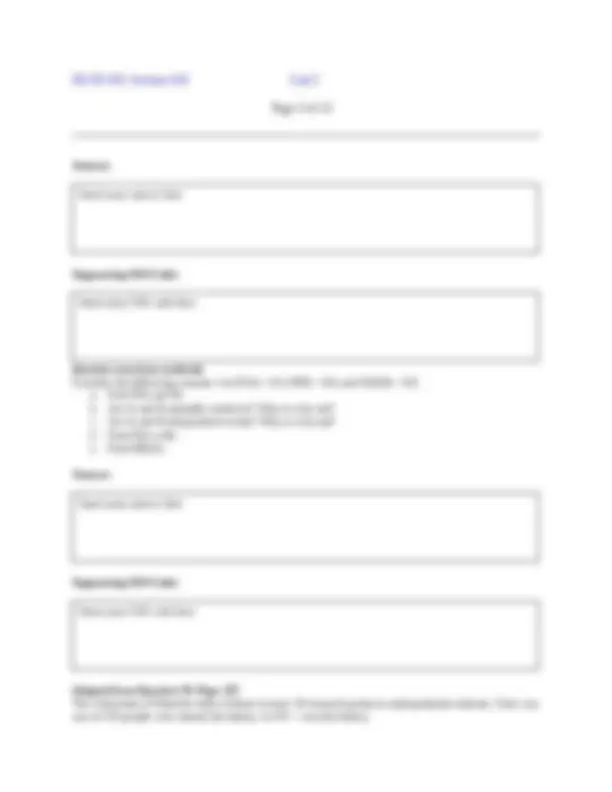
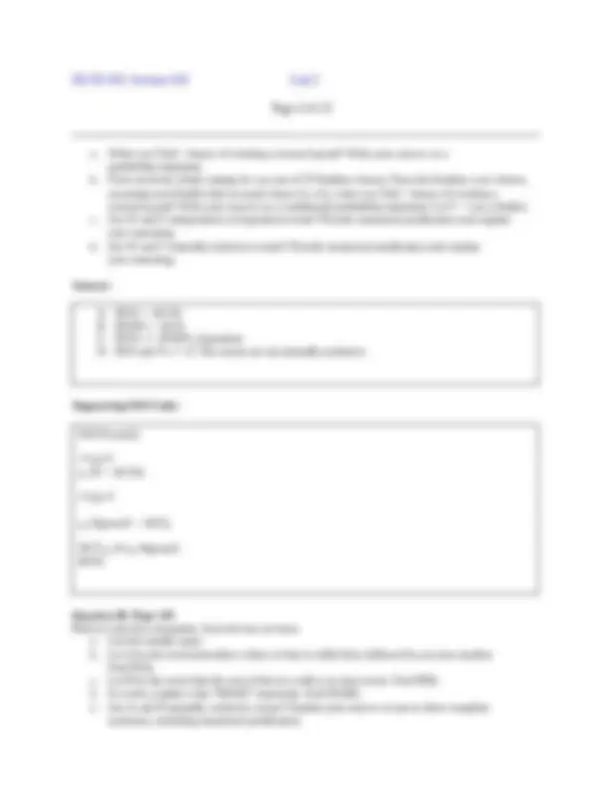
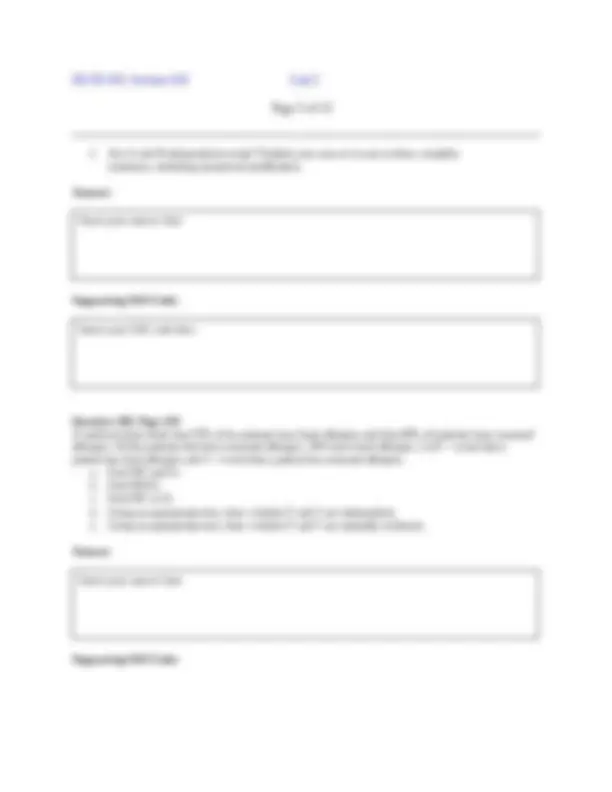
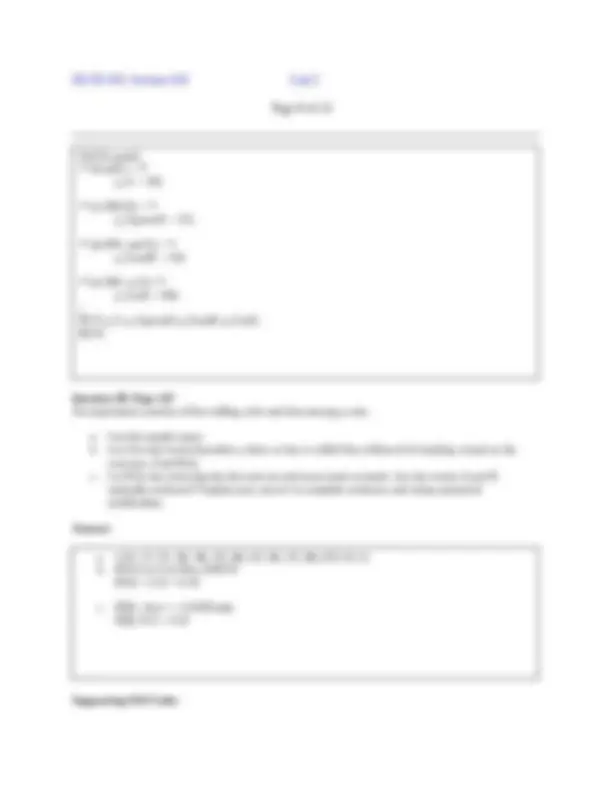

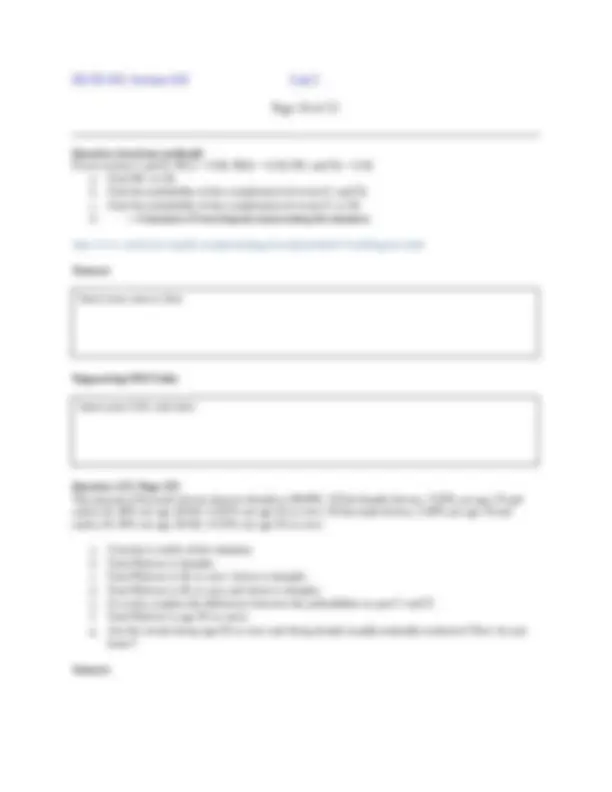


Study with the several resources on Docsity

Earn points by helping other students or get them with a premium plan


Prepare for your exams
Study with the several resources on Docsity

Earn points to download
Earn points by helping other students or get them with a premium plan
Community
Ask the community for help and clear up your study doubts
Discover the best universities in your country according to Docsity users
Free resources
Download our free guides on studying techniques, anxiety management strategies, and thesis advice from Docsity tutors
Be sure to support your solutions with the supporting SAS code, where appropriate. Question (not from textbook) A and B are mutually exclusive events. P(A) = 0.3; P(B) = 0.6. Find a. P(A and B) = b. P(A∣B) = c. P(A or B) =
Typology: Exams
1 / 12

This page cannot be seen from the preview
Don't miss anything!







a. P(A and B) = P(A|B) * P(B) = 0. b. A and B are not mutually exclusive since P(A and B) is not equal to 0 c. A and B are not independent since P(B|A) does not equal P(A). d. P (A or B) = 0. e. P(B|A) = 1. Not possible for probability to be 180%. /Q1/ DATA prob; INPUT p_A p_B p_AgivenB; /* part a */ p_AandB = p_AgivenB p_B; / part d / p_AorB = p_A + p_B - p_AandB; / part e */ p_BgivenA = p_AandB / p_A; CARDS; 0.3 0.6 0. ; RUN; PROC PRINT DATA=prob; RUN; Be sure to support your solutions with the supporting SAS code, where appropriate. Question (not from textbook) A and B are mutually exclusive events. P(A) = 0.3; P(B) = 0.6. Find a. P(A and B) = b. P(A∣B) = c. P(A or B) = Answer: Supporting SAS Code:
Insert your answer here Insert your SAS code here Insert your answer here Insert your SAS code here
Question (not from textbook) C and D are mutually exclusive events. P(C) = 0.1; P(D) = 0.1. Find a. P(C and D) = b. P(C∣D) = c. P(C or D) = Answer: Supporting SAS Code: Question (not from textbook) A and B are independent events. P(A|B) = 0.5. Find P(A). Answer: Supporting SAS Code: Question (not from textbook) C and D are independent events. P(C|D) = 0.9. Find P(C).
C. P(W) =/= P(W|F), dependent. D. P(W and F) =/= 0. The events are not mutually exclusive. DATA prob2; /* (a) / p_W = 10/135; / (b) */ p_WgivenF = 10/25; PUT p_W p_WgivenF; RUN;
a. What was Chris’ chance of winning a research grant? Write your answer as a probability statement. b. Chris received a letter stating he was one of 25 finalists chosen. Once the finalists were chosen, assuming each finalist had an equal chance to win, what was Chris’ chance of winning a research grant? Write your answer as a conditional probability statement. Let F = was a finalist. c. Are W and F independent or dependent events? Provide numerical justification and explain your reasoning. d. Are W and F mutually exclusive events? Provide numerical justification and explain your reasoning. Answer: Supporting SAS Code: Question 86. Page 224 Roll two fair dice separately. Each die has six faces. a. List the sample space. b. Let A be the event that either a three or four is rolled first, followed by an even number. Find P(A). c. Let B be the event that the sum of the two rolls is at most seven. Find P(B). d. In words, explain what “P(A|B)” represents. Find P(A|B). e. Are A and B mutually exclusive events? Explain your answer in one to three complete sentences, including numerical justification.
Insert your answer here Insert your SAS code here Insert your answer here
f. Are A and B independent events? Explain your answer in one to three complete sentences, including numerical justification. Answer: Supporting SAS Code: Question 100. Page 226 A medical clinic finds that 25% of its patients have food allergies and that 40% of patients have seasonal allergies. Of the patients that have seasonal allergies, 20% have food allergies. Let F = event that a patient has food allergies and S = event that a patient has seasonal allergies. a. Find P(F and S). b. Find P(F|S). c. Find P(F or S). d. Using an appropriate test, show whether F and S are independent. e. Using an appropriate test, show whether F and S are mutually exclusive. Answer: Supporting SAS Code:
a. {G1,G2,G3,G4,G5,Y1,Y2,Y3} b. P(G)=5/ c. P(G|E) = 2/ d. P(G and E) = 2/ e. P(G or E) = 6/ f. P(G and E) =/= 0, so not mutually exclusive // you can draw a green card and even numbered card.
Question 85. Page 223 Suppose that you have eight cards. Five are green and three are yellow. The five green cards are numbered 1, 2, 3, 4, 5. The three yellow cards are numbered 1, 2, 3. The cards are well-shuffled. You randomly draw one card. G = card drawn is green. E = card drawn is even numbered. a. List the sample space. b. P(G) = c. P(G|E) = d. P(G and E) = e. P(G or E) = f. Are G and E mutually exclusive? Justify your answer numerically. Answer: Supporting SAS Code: Insert your SAS code here
a. {1H, 1T, 2T, 2H, 3H, 3T, 4H, 4T, 5H, 5T, 6H, 6T}-N= b. P(A) 3 or 4 in Dice AND H P(A) = 2/12 = 0. c. P(B) : dice >= 4 AND tails P(B) 3/12 = 0.
Question 88. Page 223 An experiment consists of first rolling a die and then tossing a coin. a. List the sample space. b. Let A be the event that either a three or four is rolled first, followed by landing a head on the coin toss. Find P(A). c. Let B be the event that the first and second tosses land on heads. Are the events A and B mutually exclusive? Explain your answer in complete sentences and using numerical justification. Answer: Supporting SAS Code: DATA prob3; /* (b) p(G) = / p_G = 5/8; / (c) P(G|E) = / p_GgivenE = 2/3; / (d) P(G and E) = / p_GandE = 2/8; / (e) P(G or E)= */ p_GorE = 6/8; ; PUT p_G p_GgivenE p_GandE p_GorE; RUN;
Insert your answer here Insert your SAS code here
Question (not from textbook) Given events C and D: P(C) = 0.56; P(D) = 0.34; P(C and D) = 0.18. a. Find P(C or D). b. Find the probability of the complement of event (C and D). c. Find the probability of the complement of event (C or D). d. Construct a Venn diagram representing the situation. http://www.medicine.mcgill.ca/epidemiology/Joseph/pbelisle/VennDiagram.html Answer: Supporting SAS Code: Question 123. Page 231 The percent of licensed drivers that are female is 48.60%. Of the female drivers, 5.03% are age 19 and under; 81.36% are age 20-64; 13.61% are age 65 or over. Of the male drivers, 5.04% are age 19 and under; 81.43% are age 20-64; 13.53% are age 65 or over. a. Construct a table of the situation. b. Find P(driver is female). c. Find P(driver is 65 or over | driver is female). d. Find P(driver is 65 or over and driver is female). e. In words, explain the difference between the probabilities in part C and D. f. Find P(driver is age 65 or over). g. Are the events being age 65 or over and being female usually mutually exclusive? How do you know? Answer:
Age group F M 19 and under: L P(L|F) = 0.503 P(L|M) = 0. 20-64: D P(D|F) = 0.8136 P(D|M) =0. 65 and over: U P(U|F) = 0.1361 P(U|M) = 0. Total P(F) = 0.4860 P(M) = 0. Supporting SAS Code: b. P(driver is female) = 0. c. P(driver is 65 or over | driver is female) = 0. d. P(Driver is 65 or over AND is female) = P(U and F) = P(U|F) * P(F) = 0. e. For part C, we are interested in drivers aged 65 in the female driver sample, for part D we are interested and female drivers aged 65+ within the entire sample. f. (P) driver is age 65 or over) = P(U)=P(U|F) * P(F) + P(U|M) * P(M) = (0.13610.4860) + (0.13530.5140) = 0. g. Are the events being age 65 or over and being female usually mutually exclusive? They are not mutually exclusive since these two events can occur together, i.e., P(U and F) =/= 0 (i.e. you can be over 65 and a female. a.